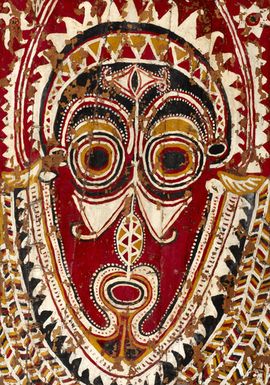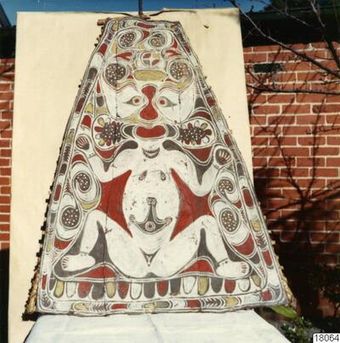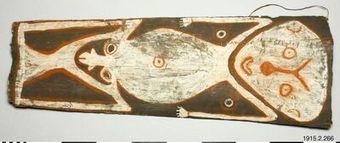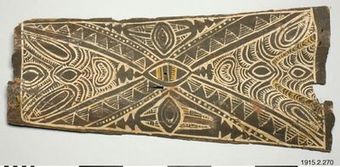Connect with Horniman Museum and Gardens
Contact this content partner to get more information about this item.
painting
- Description:
- Painted Panel from a Haus Tambaran, Abelam People, Middle Sepik River, Papua New Guinea. Like their neighbours the Arapesh, Iatmul, Kwoma and Wam, the Abelam practice the major Middle Sepik cultural institution of the haus tambaran. This remarkable event involves the erection of a huge house with an elaborately decorated façade. The events of the tambaran are sacred and secret to the Abelam men, and revolve around the initiation of boys into manhood. The principal spiritual figure of the Abelam, Nggwalndu is depicted alongside other important ancestral beings on painted bark panels such as this, which fill the high façade of the haus. Forbidden to the sight of women and uninitiated boys, Nggwalndu occupies the haus throughout the duration of the tambaran, and terrifies all around with unnatural whirring and moaning noises all night long. At the climax of the ceremony, each boy must enter the haus and face Nggwalndu to become a man. Bark, pigment. Collected in 1962 for the Horniman Museum by Professor Anthony Forge during his second period of fieldwork among the Abelam, whilst a lecturer at the London School of Economics. Gable end panel from a 'haus tambaran'. The panel is of bark mounted on a rectilinear grid framework and is painted in four colours: black, white, red and yellow. The depiction is of an anthropomorphic face and the subject is Nggwalndu, the ancestral deity of the Abelam people. In the haus tambaran, boys undergo initiation and meet Nggwalndu. This image depicts his presence to the women and initiated children who are forbidden to enter the initiation house.
- Format:
- image
- Collections:
- Horniman Museum and Gardens
- Content partner:
- Horniman Museum and Gardens
- Availability:
- Not specified
-
Copyright status: All rights reservedFind out more about what you are able to do with this itemThis item is all rights reserved, with means you'll have to get permission from Horniman Museum and Gardens before using it. For more information, please see our use and reuse page.More informationHorniman Museum and Gardens has this to say about the rights status of this item:
http://rightsstatements.org/vocab/InC/1.0/
What can I do with this item?Non-infringing useNZ copyright law does not prevent every use of a copyright work, and this item may be hosted by an international institute or organisation. You should consider what you can and cannot do with a copyright work.No sharingYou may not copy and/or share this item with others without further permission. This includes posting it on your blog, using it in a presentation, or any other public use.No modifyingYou are not allowed to adapt or remix this item into any other works.No commercial useYou may not use this item commercially.
Welcome and warm Pasifik greetings
The information on this site has been gathered from our content partners.
The names, terms, and labels that we present on the site may contain images or voices of deceased persons and may also reflect the bias, norms, and perspective of the period of time in which they were created. We accept that these may not be appropriate today.
If you have any concerns or questions about an item, please contact us.



